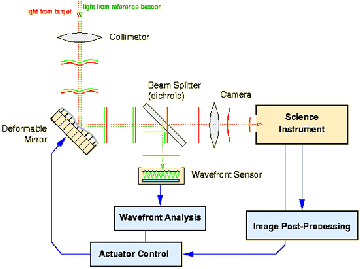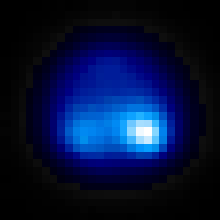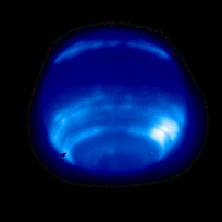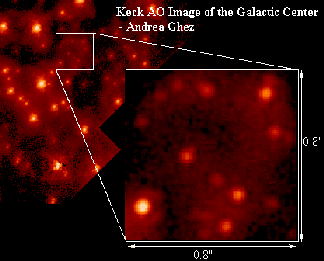Last December, astronomers commanded the world’s biggest telescope, perched near the windswept summit of Hawaii’s Mauna Kea, to gaze deep into the Andromeda galaxy. The W.M. Keck II Telescope had studied the galaxy, one of our nearest neighbors, many times before, but now the stakes were higher.




The 10-meter instrument had recently been outfitted with a rapidly adjustable mirror designed to minimize the distortions imposed by Earth’s turbulent atmosphere. If the new system worked, astronomers would see details no groundbased telescope had ever seen before.
Inside the telescope’s control room 11,000 feet below the mountain’s summit, engineer D. Scott Acton and his colleagues closely monitored Keck’s progress. One hundred stars, near-pinpoints of light, popped into view. “It was just incredible,” recalls Acton, “to realize we were sitting there, the first humans to see those stars.” Such images graphically reveal the transformation the Keck II Telescope has undergone. It and its twin, Keck I, were already renowned for their ability to capture sharp images of the heavens. Thanks to its corrective mirror, which flexes hundreds of times a second to compensate for Earth’s rapidly changing atmosphere, Keck II now can take near-infrared pictures that are 20 times more detailed than before. Some of the images have four to five times the resolution recorded in infrared light by the Hubble Space Telescope.
Pinpoint image
Light from a distant star or galaxy races across space like ocean waves moving in parallel across the sea. Each crest marks a wave front, a surface moving uniformly at constant speed. Under ideal conditions, a telescope intercepting and focusing such a wave would form a pinpoint image corresponding to the original light source.
Earth’s atmosphere, however, is not a uniform optical medium. Variations in temperature and density create patches of air that deflect or slow the light passing through them. When a wavefront runs into the atmosphere, it breaks into an incoherent mess, and a telescope attempting to focus this light creates a fuzzy, quivering blob.
If Earth had no atmosphere, a large ground-based telescope could concentrate light from a heavenly object into a spot. Its width would be determined only by diffraction—the unavoidable spreading of light rays as they pass through an optical system. Even at its calmest, however, the atmosphere blurs star images to a diameter at least 10 times greater than a large telescope’s natural diffraction limit.
Not only does the atmosphere cause the image to wobble, it also changes the brightness from moment to moment. In short, stars—and galaxies—appear to twinkle, and astronomers try their hardest to take the twinkle out.
They have two options. They can launch observatories into space, well above the troublesome atmosphere. That’s a costly proposition, however, and not everyone has a spare $2 billion for a device like the orbiting Hubble Space Telescope.
For telescopes on the ground, scientists can try to undo the damage that the atmosphere inflicts. Some have begun doing just that. Their first step is to assess the distortion. Because the blurring changes so quickly, this measurement must be repeated many times a second.
Astronomers have devised systems that measure twinkling by analyzing the image of a nearby reference source, such as a bright star near the object of interest. First, they measure how much the reference star’s appearance deviates from that of a point source of light. Then a computer calculates how to cancel out the twinkling by altering the shape of a small deformable mirror within the telescope. Tiny pistons in back of the mirror change its shape hundreds of times a second.
“We have this nonplane wave that hits the deformable mirror, but by the time it bounces off, it’s a plane wave again,” says Acton. The basic idea of such systems, known as adaptive optics, was first proposed by astronomers in the 1950s. They came up with a practical design more than a decade ago, working from earlier military designs to detect faint targets, such as spy satellites. Several adaptive optics systems are now in use, with Keck II ranking as the biggest telescope to get this fix. Its deformable mirror features 349 pistons that can push and pull up to 672 times a second.
Engineers plan to install a similar device on Keck I this summer. “The idea [of using adaptive optics in astronomy] has been around for a decade, but now we’re going from a formula to the real thing,” says astronomer John C. Mather of NASA’s Goddard Space Flight Center in Greenbelt, Md.
“It’s a very, very simple concept, but it’s almost impossible to do in practice,” notes Acton. Among the obstacles, an adaptive optics system requires a bright reference source close to the heavenly object that an astronomer wishes to study. That requirement typically permits a system to observe only a small fraction of the sky. Indeed, Keck’s current setup can operate over less than 10 percent of the heavens.
To expand their horizons, scientists recently developed laser systems that create reference stars on demand. Intense laser light directed into the sky tickles a layer of sodium atoms 90 kilometers above Earth. The radiation emitted by the stimulated atoms acts as an artificial star. A laser system is expected to be in operation at Keck II by the end of the year, Acton says.
Researchers are also testing systems that have multiple lasers and more than one deformable mirror. These would enable astronomers to more precisely eliminate atmospheric distortion and enlarge adaptive optics’ field of view.
A more intractable problem is that adaptive optics works best at long wavelengths, where atmospheric distortion has less effect. For instance, it’s much more effective for observations in the near-infrared than in visible light.
Keck’s enhanced vision has already inspected a range of celestial sights—storms on Neptune, a lava fountain on Jupiter’s moon Io, brown dwarfs in the Milky Way, and black holes in galaxies far beyond. Acton and other astronomers unveiled the new images in January at a meeting in Atlanta of the American Astronomical Society.
“As you sit at the control room for this adaptive optics system at the telescope night after night after night, it gets to become routine,” says Acton. “But every now and then, I stop and really think about what we’re doing. . . . If you look at some of the higher-resolution images that we’ve taken, they’re equivalent to pointing a telescope at somebody who’s standing 250 miles away from you and saying, ‘Oh, I know that dude.'”
Giant storm
Last May, Keck II homed in on a giant storm featuring ferocious winds. Claire E. Max of the Lawrence Livermore (Calif.) National Laboratory and her colleagues were using the system to record the sharpest images of Neptune ever taken from Earth.
Other telescopes, including Hubble, had already viewed this storm, located in the planet’s southern hemisphere. However, they could not accurately discern its size. Without adaptive optics, it had appeared to cover one-third of the planet’s disk, but the sharper Keck II observations show that the storm is less than one-tenth that size.
Such information will be crucial to understanding how the storm arose and maintains its shape, says Max. Unlike Earth, Neptune gives off more energy than it receives from the sun. The heat generated from its core, which is still undergoing gravitational contraction, powers the violent activity at the planet’s surface, including winds blowing up to 1,800 kilometers per hour.
In 1989, Voyager flew past Neptune and spied another storm, dubbed the Great Dark Spot because of its appearance in visible light. That spot, about 20º south of the planet’s equator, has since disappeared, and planetary scientists are curious if the new storm, which is much farther south, bears any similarity. One clue that it may differ is that the storm region, which appears bright in near-infrared light, does not look dark in visible light.
Max and her colleagues also viewed the surface of Saturn’s moon Titan, which is surrounded by a hydrocarbon haze. Theory suggests that sunlight breaks some of the methane in Titan’s atmosphere into ethane, which may rain down on the surface and form lakes or oceans.
Keck’s near-infrared portrait shows a surface mottled with light and dark patches. The images are sharp enough that Max hopes to use a newly installed Keck II spectrograph to determine the composition of the patches. “The real promise of these Titan images is actually to be able to lay a spectrograph slit across them . . . and not have the spectrum at one point be contaminated by light that dribbles in from some other place,” she says.
In particular, Max hopes to determine whether the dark patches are lakes. If she succeeds, adaptive optics will have achieved a major discovery about Titan well before the Saturn-bound Cassini mission parachutes a probe onto the icy moon in 2004.
A chance observation of Jupiter’s volcanically active moon Io appears to have had a special payoff. Last November, the Galileo spacecraft obtained a close-up view of Io. The craft observed a fiery fountain of lava shooting more than a mile above a volcanic crater on the moon’s surface. The lava was so hot and bright that it overexposed part of the Galileo image, leaving a bright blur.
Two days later, Keck II happened to take a look at Io. The Keck image shows a bright spot extending from the illuminated edge, or limb, of the moon. “We honestly didn’t know that Galileo had discovered a rarely seen lava fountain, a kind of Mount Saint Helens, on Io,” says Acton. The orientation of the bright feature seen by Keck suggests it’s the same lava fountain “shooting out off the limb of the moon,” he says.
“Small” structures
Viewing the center of our galaxy, the site of a suspected black hole, the Keck system can discern structures as small as five times the size of the solar system. This enables astronomers to examine structures one-tenth the size previously attainable.
Keck’s adaptive optics also is shedding light on distant galaxies, which appear as they were when the universe was young. These youthful galaxies tend to be smaller than today’s, and their visible light has been shifted to the infrared by cosmic expansion, notes James E. Larkin of the University of California, Los Angeles.
In some of the more remote galaxies, billions of light-years from Earth, Keck can discern features as small as 8,000 light-years across. That’s one-fifteenth the size possible without adaptive optics.
Last April, Larkin and his colleagues used the telescope to take the sharpest image ever recorded of a distant, faint galaxy. This galaxy happened to lie near a bright reference star.
Observations reveal that the galaxy resides about 4 billion light-years away, indicating that it hails from a time when the cosmos was about two-thirds its current age. The researchers found that the core of the galaxy, a region extending 1,000 light-years from the center, shines brightly.
Either the region is undergoing a burst of star formation or a giant black hole has gathered stars around it, Larkin says. Velocity measurements of the stars, which he hopes to take with the new spectrograph, should determine why this region is abuzz with activity.
Hunting planets
Another revolution may be waiting in the wings at Keck. A near-infrared camera that astronomers hope to install within the year may prove an invaluable tool for hunting planets outside the solar system, says David E. Trilling of the University of California, Santa Cruz. The camera features a coronagraph, a mask that blocks out the glaring light from stars and allows astronomers to search for the extremely faint light from companion objects—either brown dwarfs or planets.
In combination with the adaptive optics system, the camera might produce the first images of extrasolar planets, says Trilling. “I have a feeling that bizarre and wonderful planets and brown dwarfs will fall out of the sky almost immediately,” he predicts.







